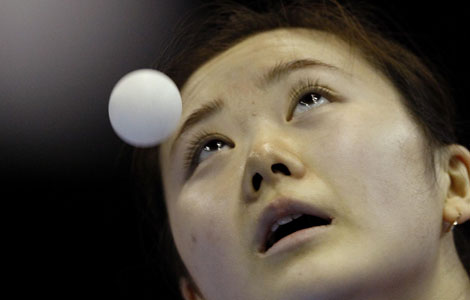PMI fall signals contraction
Updated: 2011-12-02 09:22
(Xinhua)
|
|||||||||
BEIJING - Fresh PMI data confirmed slowdown in the world's second-largest economy, fueling speculation that Chinese policy makers may shift more focus to steering the economy through hard times.
Purchasing Managers' Index (PMI), a preliminary indicator of China's manufacturing activity, dropped to 49 percent in November from October's 50.4 percent, indicating contraction for the first time since its last under-50-percent reading in February 2009, the China Federation of Logistics and Purchasing (CFLP) said Thursday.
A PMI reading of 50 percent demarcates expansion from contraction. The PMI has been around 50-51 percent since June of this year.
Indicators point to slowdown
The fall in November's PMI confirmed a continuous trend of cooling growth, but the pace of the growth slowdown will remain steady and there will be a slim chance for great fluctuations, said CFLP Deputy Director Cai Jin.
Zhang Liqun, a researcher with the Development Research Center of the State Council, or China's Cabinet, echoed Cai's comment, saying a relatively strong momentum of domestic investment and consumption will help stave off a plunge.
The CFLP's sub-index for export orders fell sharply to 45.6 percent in November from October's 48.6 percent, suggesting that the spreading Eurozone debt crisis and weakened demand from both the European Union and the United States were wearing down the growth in the world's second-largest economy.
"The contracting demand is squeezing profitability out of the manufacturing industry and dampening business confidence," said Peng Wensheng, an analyst with China International Capital Corp.
A slowing profit increase will then further constrain companies from expanding production and investment, he said.
China's economic growth has been slowing all this year, with Europe and the United States -- the country's two largest trade partners -- struggling for recovery from the global financial crisis and its aftermath.
Domestically, the country's efforts to restructure its economic growth pattern, anti-inflation fight and policies to ease the runaway property prices also weighed on growth.
The country's GDP growth slowed to 9.1 percent in the third quarter of the year, from 9.5 percent in the second quarter and 9.7 percent in the first quarter.
Exports, one of the three engines used to power the country's fast expansion, weakened 7.2 percent month-on-month in October, while imports dropped 9.5 percent month-on-month.
Industrial enterprises saw their profits increase 25.3 percent year-on-year in the first 10 months of 2011, slowing down from the year's previously recorded figures.
Concerns over slowing growth have dragged the key Shanghai index down by more than 20 percent from this year's peak in April.
The preview of HSBC China's PMI for November dropped from October's 51.0 to 48.0, the lowest level in the past 32 months.
However, the slowdown seems to have helped ease pressure on prices. The CFLP's sub-index for purchase prices fell 1.8 percentage points from October to 44.4 percent last month.
The country's consumer price index, a main gauge of inflation, increased 5.5 percent year-on-year in October, easing from this year's peak of 6.5 percent in July.
Growth outweighs curbing inflation
Faster-than-thought growth slowdown and abated inflation pressure would seem to have made the country's policy makers shift economic focus, analysts said.
China's vice minister of finance Zhu Guangyao said on Thursday that promoting economic growth should be given top priority for now under the current grim environment.
Overnight, the country's central bank unexpectedly announced it would lower the reserve requirement ratio (RRR) for banks by 50 basis points for the first time in three years.
Peng Wensheng said the central bank's move sent a signal of policy stance change. However, there were also economists arguing that it is not yet known if the change will bring about a full-on move toward a looser monetary policy.
China's move was separate but similar to a coordinated action taken by six other central banks -- pumping liquidity into the financial system.
For more than a year, China has been squeezing the banking system in efforts to rein in high inflation.
The country's central bank has raised the RRR for banks by 12 times since January 2010, bringing the ratio to a record high of 21.5 percent for large commercial banks.
Although the tightening stance helps ease consumer price rises, it also leads to increasing complaints about credit strains from the country's businessmen, especially the small enterprises.
"Judging from the PMI figures, China is experiencing the most difficult time since the global financial crisis in 2008 and the situation demands the Chinese government further loosens its policies," said Liu Ligang, director of the economic research department of ANZ Greater China.
Liu said the RRR cut announcement will just be the beginning, and he expected another RRR cut in Dec. and three more cuts in the first half of next year.











